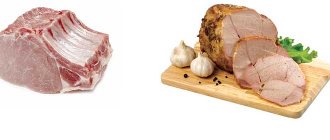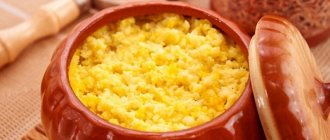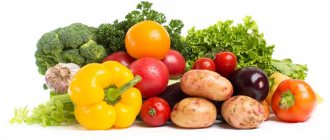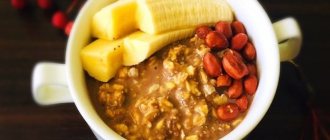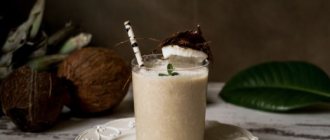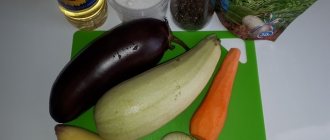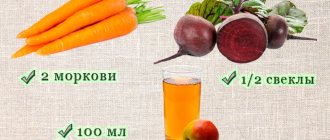Pumpkin is a healthy food product that can rightfully be called a natural multivitamin. All substances that make up the bright pulp do not lose their benefits even during heat treatment. In addition, pumpkin seeds are another source of health. It is recommended not to throw them away, but to dry them and save them: in the spring they will help prevent vitamin deficiency and other health problems.
Decorative varieties of this plant can decorate the interior and delight the eye with their bright colors and impeccable shapes. Back in the old days, when sweets such as ice cream and chocolates were rare, a piece of baked sweet pumpkin was considered a real delicacy. The secret of the longevity of our ancestors can be explained by the fact that their daily diet was rich in healthy foods. Without having any special knowledge, they, relying on personal experience, were convinced of the beneficial effects of pumpkin on the body.
A little history
Content:
- A little history
- How it grows
- Compound
- Beneficial features
- Medicinal recipes
- Is it possible to retain beneficial properties after processing?
- Benefits of pumpkin juice
- Benefits of pumpkin seeds
- Benefits of pumpkin oil
- Pumpkin in cooking
- Application in cosmetology
- For weight loss
- Contraindications and harm
Pumpkin is an ancient crop. It came to Europe in the 19th century from Central America after potatoes and tobacco. Today, more than 20 varieties of this vegetable are known, differing in taste, color and size.
In many countries, pumpkin is rightfully considered the queen of vegetables. The American Indians were of the opinion that it was a cosmic eye connecting man with the Universe. The British believed that when sowing a pumpkin on Holy Friday, an oak tree would grow.
Contraindications
The main disadvantage of pumpkin is its ability to accumulate nitrates, therefore, when buying a vegetable, it is important to know in which region it was grown. Products from countries where chemical fertilizers and pesticides are heavily used in agriculture should be avoided.
In its raw form, pumpkin is contraindicated for people during periods of exacerbation of gastric and intestinal diseases (gastritis, ulcers), as well as with inflammation of the gallbladder and intestinal colic.
Doctors also do not recommend overusing pumpkin juice. To replenish nutrients, it is enough to drink it 1-2 times a week, 200-250 ml.
How it grows
Pumpkin is a dioecious, monoecious, annual herbaceous plant. It has a very powerful root system, which consists of a main tap root, the penetration depth of which is 1–1.7 m, and small, lateral, adventitious suction roots. Their main part is located at a depth of 40–50 cm, while other roots can penetrate 4–5 m deep. Lateral horizontal branches of the roots from the stem can spread over a radius of 4–5 m or more. The roots of one plant can have a total length of up to 25 km.
The creeping stem of a pumpkin can grow up to 4–5 m. First-order shoots come from the main stem, and second-order shoots from them, etc.
The leaves of the plant are quite large, have long stalks, and can reach up to 25 cm in diameter. Flowers and tendrils appear in the axils of each leaf. Varieties that are more resistant to drought and heat are characterized by the presence of a highly demarcated leaf blade. In some of them, aerenchyma can form - air-bearing tissue under the epidermis, the purpose of which is to protect the leaf from overheating. Some gardeners may mistakenly mistake areas of aerenchyma on the leaf surface for traces of disease.
The plant has large flowers of orange or yellow color. Female flowers can differ in size, color and shape, depending on the variety and type of pumpkin. The flowers are predominantly solitary, unisexual, but hermaphrodite can also be found. The number of male flowers exceeds the number of female flowers by 20–25 times. Females are more often located on the side braids of the first order, and males - on the main stem.
The fruit of the plant is a multi-seeded false berry (pumpkin), reaching large sizes and having different colors and shapes (from serpentine to round). The seed cavity of the pumpkin contains placentas with seeds. The pulp of the plant is distinguished by a variety of colors - from reddish-yellow and orange to cream and white. For most varieties, fruits can weigh 4–10 kg, for large-fruited ones - about 100 or even 200 kg. Their diameter can reach up to 1 m.
The seeds are covered with a peel or they are bare, ellipsoidal in shape, of different colors and sizes (depending on the variety). They are able to remain viable for 4–5 years. Pumpkin is a moisture- and heat-loving plant: germination of its seeds begins at +13–14 °C, but the most favorable temperature for this can be considered +20–25 °C. The vegetable is extremely sensitive to temperature changes at an early age: it dies at -1 °C. The growth of lashes and stems occurs at a temperature not lower than +12–15 °C, and the optimal temperature for fruit development is considered to be +25–27 °C.
Classic recipe
Classic oven-baked pumpkin is the simplest recipe. Its calorie content is low due to the absence of oil, sugar and other additives.
Composition of ingredients
To prepare the dish you need:
- fresh pumpkin – 1 pc.;
- water (volume depends on the number of servings);
- clay pots.
Step-by-step cooking process
To make the dish tasty, you must strictly follow the cooking instructions:
- Before cooking, the vegetable must be washed and cut into 2 halves. The seeds in the cut halves should be removed with a tablespoon.
- You definitely need to cut off the crust of the pumpkin. It is removed with a knife or hand peeler. You should clean it carefully, as the crust is very dense and slippery.
- After peeling, the vegetable must be cut into small pieces or slices. The size of the pieces affects the quality of cooking. Slices or cubes that are too large may not bake well, which will affect the taste.
- Next you need to prepare the pots. Before use, the dishes should be washed and dried with a napkin. It is recommended to place vegetables in pots up to the top with a slide. For 4 servings you will need 1 kg of pumpkin. The pots need to be filled with 50 ml of water.
- The pots with the contents should be covered with a lid and placed on a baking sheet so that they stand stable. Next you need to put the pots in the oven. It is recommended to bake at 180°C for 1 hour. The duration of heat treatment may vary depending on the size of the pieces or the quality of the pumpkin.
- At the end of the hour, the dish must be removed from the oven and then checked for readiness. The product is considered fully baked if the inserted tines of a fork easily penetrate the pulp. If you feel that the pieces are still a little hard, put the pots in the oven for a few more minutes.
What can I add?
Sugar can be added to taste. At the end of cooking, you can add honey instead of sugar. You shouldn't add it right away. During heat treatment, honey loses trace elements and vitamins. You don't have to add anything to the dish. In this case, the pumpkin will taste bland.
How to serve a dish
It is advisable to serve the dish on the table in a beautiful plate, pouring honey over the pieces. Can be consumed both warm and cold. A dish with honey has a pleasant sweet taste, so it is suitable as a dessert for tea.
Compound
The pumpkin fruit consists of peel (about 17% of the total mass), pulp (up to 73%) and seeds (about 10%). Pumpkin is a natural source of many important minerals and vitamins that have beneficial effects on the body.
Table 1 “Chemical composition of pumpkin” [1]
| Component | Content, g per 100 g |
| Squirrels | 1 |
| Carbohydrates | 4,4 |
| Fats | 0,1 |
| Alimentary fiber | 2 |
| Water | 91,8 |
| Organic acids | 0,1 |
| Ash | 0,6 |
| Starch | 0,2 |
| Sugar | 4,2 |
| Vitamins, mg | |
| Vitamin A (retinol) | 0,25 |
| Vitamin B1 (thiamine) | 0,05 |
| Vitamin B2 (riboflavin) | 0,06 |
| Vitamin B5 (pantothenic acid) | 0,4 |
| Vitamin B6 (pyridoxine) | 0,1 |
| Vitamin B9 (folic acid) | 0,0014 |
| Vitamin B3/PP (niacin) | 0,7 |
| Vitamin C (ascorbic acid) | 8 |
| Vitamin E (tocopherol) | 0,4 |
| Macro- and microelements, mg | |
| Potassium | 204 |
| Calcium | 25 |
| Sodium | 4 |
| Magnesium | 14 |
| Sulfur | 18 |
| Phosphorus | 25 |
| Chlorine | 19 |
| Zinc | 0,24 |
| Iron | 0,4 |
| Iodine | 0,001 |
| Manganese | 0,04 |
| Copper | 0,18 |
| Fluorine | 0,086 |
| Cobalt | 0,001 |
The energy value of pumpkin is 22 kcal.
Use in dietetics and weight loss
Pumpkin is a very low-calorie product with a healthy composition. It can be safely consumed on a diet and under restrictive regimes. Even pumpkin pie will not be as high in calories as it seems at first glance due to the presence of dough there. In any case, nutritionists recommend this product for consumption, and you will find out why below. Here are some interesting facts about pumpkin!
- Pumpkin consists of almost 90% water, due to which it has incredible diuretic and choleretic properties.
- A huge number of carotenoids are contained in this product, and the brighter the color, the more there are.
- Pumpkins are stored for a very long time, and this is undoubtedly a big plus of the product. Under proper conditions, it can last a year without deteriorating at all!
- Pumpkin seeds are useful for men for potency and maintaining their libido in good shape. The same can be said about women's health, but for men their effect will still be predominant.
- In cooking, this product is indispensable and very versatile. You can cook anything with it, serving it as an appetizer, as a side dish, or as a main dish.
- It was with pumpkin that the first cream soups began to be made, and it still remains the best basis for this most delicate dish. And it has a lot of advantages: a simple recipe, cheap ingredients, and at the same time, tasty and healthy!
- It is not surprising that the product is popular among nutritionists, as the main recommendation for their patients, and among those losing weight, as a permanent guest in the refrigerator, because it contains a minimum of calories and maximum benefits, and at the same time, it is very easy to prepare. Moreover, only a few people don’t like this product, because it can be prepared in different ways, which means it can please more people.
Beneficial features
Pumpkin is a very healthy product. This is an almost waste-free vegetable, because both pulp and seeds can be used for food.
The high potassium content strengthens blood vessels and also improves cardiac activity [2].
A successful combination of potassium and magnesium is beneficial for women who care about their figure. This combination will help the body get rid of excess water and, as a result, cellulite. For the same reason, pumpkin puree is recommended for people who suffer from edema associated with kidney pathology.
Pumpkin is rich in iron, so it should be included in the diet of people with anemia [3]. This mineral is found not only in the pulp of the vegetable, but also in its seeds. By consuming several handfuls of seeds daily, you can satisfy the body's daily need for this microelement. Iron plays an important role in the activity of the immune system, the formation of interferon and phagocytes, so dishes made from this vegetable are very relevant during epidemics of ARVI and influenza.
The zinc present in pumpkin takes part in building the skeletal system. It is not for nothing that village women who regularly use this healthy product are less likely to encounter cases of age-related osteoporosis than city women of the same age.
The content of zinc in the body of men is directly related to potency. With its deficiency, sexual weakness occurs. Therefore, women who expect feats from their men in bed need to feed them dishes with the addition of pumpkin.
Pumpkin is a dietary vegetable. Due to the low content of organic acids and coarse fiber in the pulp, it can be used for inflammatory diseases of the intestines and stomach [4].
Any ophthalmologist will confirm that vitamin A, contained in large quantities in pumpkin, prevents vision deterioration. Dishes made from this vegetable are recommended for people who spend a long time at the computer: it helps compensate for high visual stress. Vitamin A, also known as retinol, has another useful property - it helps prevent the occurrence of cancer. Since pumpkin is also a source of natural beta-carotene, these substances together make it possible to fight back the emergence of any neoplasms. Doctors advise people with a hereditary predisposition to cancer to take courses of multivitamins that contain beta-carotene and vitamin A. We must not forget that the absorption of retinol occurs best with fats, therefore, when preparing porridge, it is advisable to cook it in milk or add it to it vegetable or butter.
This vegetable is enriched with rare vitamin T, which is very important for the body. It helps the digestive organs cope with the digestion of fatty foods and prevents obesity [5]. That is why it is recommended to serve pumpkin puree as a side dish for beef and pork dishes. This is especially true for people with metabolic disorders who easily gain extra pounds.
The powerful natural antioxidant vitamin E contained in pumpkin in large quantities allows you to maintain the proper level of elasticity, freshness and firmness of the skin. It is useful for women planning pregnancy, because it is due to vitamin E deficiency that female infertility can occur.
Pumpkin is very rich in fiber - a real “broom” for the intestines, removing everything unnecessary. There is a direct connection between the strength of the immune system and healthy intestinal activity. Therefore, by using pumpkin to support intestinal function without constipation and other problems, you can avoid many diseases that arise as a result of a weakened immune system.
Pumpkin contains a lot of pectin, which helps remove chlorides and “bad” cholesterol from the body. Many medicines for removing radionuclides from the body include pumpkin pulp extract. It is recommended to be consumed by patients who suffer from diseases associated with high salt content in the body: gout, rheumatism, osteochondrosis.
Due to its ability to remove toxins and excess salts from the body, pumpkin is useful for kidney and liver diseases. Consumption of this vegetable, especially in the form of freshly squeezed juice, can improve a person’s health during exacerbation of colitis, cholecystitis, and cholelithiasis.
In addition, pumpkin produces a slight antiemetic effect, so it is recommended to be eaten by women during pregnancy: this product copes well with the manifestations of toxicosis without harm to health. The pumpkin diet is also effective for seasickness.
Pumpkin porridge, due to its high content of vitamins and minerals, is extremely useful in baby food. Pediatricians recommend more often preparing dishes with the addition of this vegetable for children who suffer from hyperactivity: it can calm the child’s nervous system.
Lenten pumpkin with garlic
The recipe is relevant for lovers of spicy food. Garlic, which is part of the dish, makes it tastier and piquant.
Composition of ingredients
The dish has a clear set of ingredients:
- pumpkin, cut into slices – 450 g;
- garlic – 1-2 heads;
- salt, pepper - according to taste preferences;
- olive oil – 50 g;
- basil, thyme, possibly adding oregano;
- balsamic vinegar – 10 g.
Step-by-step cooking process
For proper preparation, it is recommended to follow the recipe:
- The pumpkin should be cleaned of seeds and skin. For this recipe, it is possible to add vegetables with peel. In this case, you need to bake the product properly so that the skin becomes soft. The vegetable should be cut into slices.
- Next you need to make the seasoning. It is prepared in a deep bowl. Pour olive oil into a container, add spicy seasonings: basil, thyme, oregano. It is recommended to place the garlic cloves next to the pumpkin slices so that the dish is imbued with flavor. For lovers of spicy food, garlic can be grated.
- Place the pumpkin on a baking sheet, having previously covered it with foil. The slices are poured with a mixture of seasonings, after which the ingredients are mixed by hand. You can coat each piece separately with seasoning using a silicone brush. Next you need to put the garlic in a baking tray.
- After all the preparatory manipulations, the baking sheet can be placed in the oven. It is recommended to bake the dish at a temperature of 170-180 °C. The duration of heat treatment is 40-45 minutes.
During baking, it is advisable to check the readiness with a fork so as not to dry out the dish. Pumpkin can replace potatoes.
How to serve a dish
It is recommended to serve the dish hot with meat as a side dish. Can be consumed during lunch or dinner.
Medicinal recipes
- For hepatitis and other liver diseases, the following recipe will be useful. A glass of pumpkin seeds must be dried, crushed in a blender, and poured with a glass of olive oil. Then you need to boil everything in a water bath, cool and leave for seven days in a dark place. Strain everything and drink three times a day before meals.
- To prepare a remedy for prostatitis, you need to grind two glasses of unpeeled fresh seeds in a blender, add a glass of honey to them and mix everything. Form the mixture into balls the size of a quail egg and place them in the refrigerator. Dissolve one ball every day half an hour before meals.
- For insomnia, use the following recipe: cut 100 g of pumpkin pulp into cubes, sprinkle it with sugar and eat it an hour before bedtime. Sugar can be replaced with honey.
- If you have problems with urination, it is recommended to eat pumpkin porridge three times a day.
- To prepare a remedy for the treatment of anemia, cut the pumpkin into cubes, add a glass of water, add herbs and a teaspoon of olive oil to this mixture. Next, you need to simmer everything and consume it three times a day.
Calorie content of raw, boiled and baked pumpkin: value
Even small children are allowed to eat pumpkin when complementary foods are introduced; it is very useful for diabetics and will diversify your diet menu if you want to lose extra pounds.
And for this we invite you to look at the calorie content of pumpkin in different states per 100 g:
- A raw vegetable, depending on the variety, contains from 3 to 11% sugar, so the calorie content varies from 22 to 26 kcal. The average value is often taken as 24 kcal, which is equivalent to the calorie content of zucchini.
- Pumpkin juice
- Pumpkin nectar
- Boiled pumpkin with salt has only 20 kcal
- If you remove salt, the number of calories becomes even lower - 18 kcal
- But boiled pumpkin with sugar already has 56.6 kcal. Provided that only 10 g of sweet product was added
- Baked pumpkin with sugar (10 g) and butter (1 g) has 76.6 kcal
- If you replace sugar with honey when baking, but with butter, the calorie content will be lower - 63 kcal
- Baked pumpkin without oil, but with sugar – 53 kcal
- By baking pumpkin without oil and sugar in the oven, you will get the same low-calorie product - 25.5 kcal
- Stewed pumpkin without sugar – 25 kcal
- With sugar – 40.7 kcal
- Roasted pumpkin – 76 kcal
- Steamed pumpkin – 24 kcal
- Pumpkin flour – 305 kcal
- Pumpkin oil – 895 kcal
Important: Pumpkin seeds still belong to the group of high-calorie foods - 556 kcal per 100 g!
Compound
Is it possible to retain beneficial properties after processing?
Pumpkin can be used in any form: raw, baked, boiled, frozen. Fresh pulp is considered the most effective, but the frozen product is also able to retain almost all the beneficial properties, and it can be used at any time of the year due to the possibility of long-term storage.
The beneficial substances of the vegetable are preserved even when it is baked. Baked pumpkin has diuretic, laxative and choleretic effects. First of all, it is useful for people suffering from cardiovascular diseases and excess weight: this dish can significantly reduce the load on the heart. The vegetable can be baked in small pieces or whole, in the peel.
The Persian physician Avicenna wrote about the medicinal properties of boiled pumpkin [6]. He considered it an excellent remedy for treating lung diseases and old coughs. To prepare it, you need to divide the fruit into two parts, remove the seeds and cut into medium-sized pieces. Then you need to put everything in boiling water, add salt and cook for half an hour.
There is another opportunity to preserve the beneficial properties of the vegetable - it can be dried. When dried, pumpkin gives strength during physical activity, has a beneficial effect on the digestive system, and strengthens memory. And most importantly, it is a semi-finished product that practically does not require additional processing.
Tips and tricks
There are general recommendations on how to choose and consume pumpkin correctly to avoid unwanted consequences:
- You can determine the ripeness of a pumpkin by its tail: it should be dry and dark;
- A high-quality vegetable has thick, smooth and undamaged skin, the seeds are intact, without any foreign odor;
- the most useful are fruits with bright pulp, since they contain the largest amount of carotene;
- pumpkin is well stored, it can be eaten all winter: cut the peeled fruit into small pieces, rinse under water, using a colander to remove excess liquid, dry, put in plastic containers or tight zip-lock bags. Store at a temperature of 18-23 degrees;
- the average daily intake of steamed pumpkin for an adult is 300-400 g, for children 150-250 g. If there is an excess of vegetables in the body, nausea, vomiting, exacerbation of diarrhea, and the development of complications from the gastrointestinal tract are possible;
- Before use, make sure there are no contraindications.
And the most important piece of advice is that pumpkin is not a panacea for all diseases. More often it is considered as a preventive measure or an adjuvant in the treatment of diseases of the digestive, genitourinary, and cardiovascular systems.
It facilitates the course of the pathology, allows you to achieve positive dynamics in a shorter time, and prevent new relapses, but if used incorrectly, it can cause harm to the body. Therefore, the question of the advisability of using steamed pumpkin as a medicinal raw material should be discussed with your doctor.
Benefits of pumpkin juice
From pumpkin you can get healthy juice with a thick consistency and a pleasant honey taste, which retains almost all the substances necessary for the body. In addition to a rich set of minerals and vitamins, it has pronounced antioxidant properties. During a flu epidemic or the threat of a cold, it is recommended to drink 200 ml of pumpkin juice every morning to boost immunity. Due to its concentration, it helps well with increased nervous excitement, hemorrhoids, constipation, and vomiting. In addition, this juice can also be used to remove kidney stones.
The benefit of the drink also lies in its high pectin content, due to which it has restorative and rejuvenating effects. These abilities have found application in cosmetology. Pumpkin juice lotion helps eliminate skin redness, copes well with acne, and ensures skin regeneration at the cellular level. However, people who have increased stomach acidity should not abuse pumpkin juice, since it is the pectin in its composition that contributes to heartburn and nausea.
A freshly squeezed drink is recommended for people suffering from seasonal depression. It's all about the successful combination of vitamin C with almost all B vitamins. This combination allows, on the one hand, to relieve fatigue, increase tone, give strength, and on the other, calm the nervous system.
Pumpkin juice is useful for people with blood clotting disorders. Vitamin K present in the drink will help eliminate this problem. Its deficiency is especially acute in old age.
Benefits for various diseases
Boiled pumpkin is recommended to be included in the menu for the following diseases:
- gout;
- atherosclerosis;
- pathologies of the intestines, kidneys, liver, gall bladder;
- constipation;
- diabetes;
- obesity;
- skin lesions (dermatitis, eczema);
- diseases of the heart and blood vessels.
When losing weight
Low calorie content, high fiber and pectin content help you easily lose weight and remove excess water, which delays the weight loss process.
Pumpkin pulp increases intestinal contraction and helps eliminate “bad” cholesterol. Coarse fiber, moving through the digestive tract, cleanses the walls of waste and toxins.
Just replace starchy vegetables with boiled pumpkin during your weight loss period, lose weight easily and without failure.
For men
Zinc in the pulp regulates the production of testosterone, improves the quality of seminal fluid, prevents the development of prostatitis, and eliminates problems with urination.
For women
The vegetable is also useful for females. Due to the high content of carotenoids, pumpkin provides an even tan and improves complexion, helps remove deposits in fat traps (sides, hips, back). During menopause, it prevents the development of complications (cardiac dysfunction, osteochondrosis due to a decrease in estrogen).
Folic acid, calcium and phosphorus support a woman’s body during pregnancy and contribute to the full development of the fetus.
Vitamin E reduces the risk of gynecological diseases.
For children
100 g of boiled pumpkin puree contains the daily requirement of beta-carotene for children. The vitamin is necessary to maintain visual function, bone mineralization, and improve immunity.
Pediatricians recommend introducing pumpkin into the diet of hyperactive children. The minerals and vitamins it contains have a beneficial effect on sleep, calm the nervous system, and increase perseverance and attentiveness.
Benefits of pumpkin seeds
Pumpkin seeds contain fatty oil (approximately 40%) and a large amount of protein. Despite their high calorie content, they are very beneficial for the body due to their high content of vitamin E, zinc, salicylic acid and other elements.
Raw seeds are rich in cucurbitin, a substance that has an anthelmintic effect. Therefore, they are advised to take half a glass on an empty stomach for the purpose of preventing or treating helminthiasis [7]. Pumpkin seeds, of course, are less effective compared to synthetic antiparasitic agents, but they have a number of advantages over them: they do not cause side effects or allergies, taste good, are accessible to everyone and are harmless. Thanks to this, such seeds can be used to eliminate an unpleasant disease in pregnant women and children. Based on pumpkin seeds, the drug “Tykveol” was created, which is used to treat liver pathologies.
Due to their high zinc content, pumpkin seeds are widely used in cosmetology (both externally and internally) for problems such as seborrhea, dandruff, acne and others. They are also recommended for use by representatives of the stronger sex, since zinc also helps increase potency and the production of male hormones.
It is necessary to take into account the fact that pumpkin seeds can sometimes harm the body. Due to their high calorie content, it is not advisable to include them in the diet of people who are prone to obesity. In addition, overuse of pumpkin seeds can cause inflammation of the gastric mucosa. This can be caused by salicylic acid contained in this product [8].
Daily intake of pumpkin
How much pumpkin can you eat daily? To benefit your health and well-being, it is recommended to consume 700 grams of pumpkin daily. But the entire daily intake does not imply the absorption of such a volume in 1 approach. It is proposed to divide the specified amount into 2-3 doses.
ABC RECOMMENDS
Without salmon and avocado: how to replace expensive foods on a diet
Benefits of pumpkin oil
An oil unique in its healing properties is produced by cold pressing from pumpkin seeds. It contains vitamins and microelements, as well as essential phospholipids and flavonoids of plant origin.
The introduction of such oil into the diet helps prevent atherosclerosis, neurosis, normalize hormonal levels in women and men, and remove cholesterol. A similar product is also used in cosmetology for skin and hair.
Before using pumpkin oil, it is recommended to consult a doctor, since it has a choleretic effect, and if used incorrectly (especially in large quantities) can be harmful to health.
Pumpkin and its glycemic index
The glycemic index is a relative indicator that characterizes the rate at which carbohydrates are absorbed by the body and their effect on changes in blood glucose levels.
Carbohydrates received by the body along with food are the main source of energy to maintain its vital functions. The molecules of these components have a simple structure, so they are quickly absorbed by the body.
This causes a sharp increase in blood sugar levels and provokes the release of insulin, which regulates the functioning of the pancreas. Carbohydrates belong to the group of monosaccharides.
We recommend that you familiarize yourself with Various pictures of clover
Monosaccharides are found in sweets, baked goods, pasta, and carbonated drinks.
Excessive consumption of these products may lead to adverse effects:
- persistent feeling of hunger;
- wear and tear of blood vessels and pancreas;
- risk of diabetes.
In the absence of physical activity, simple carbohydrates in the body turn into fats and are deposited in the subcutaneous tissue.
Carbohydrates with a complex molecular structure are called polysaccharides. These include starch, glycogen, and fiber. They are slowly absorbed, so the body receives energy from them gradually and does not feel hungry for a long time.
Based on this, the glycemic index of food is determined. This indicator is measured in arbitrary units from 0 to 100. Products that contain simple carbohydrates have a high glycemic index, and products containing complex carbohydrates are classified as low in this indicator.
According to the glycemic index, products are divided into 3 groups:
- increased - more than 70 units;
- average - 56-69 units;
- reduced - up to 55 units.
This division of products was developed to organize dietary nutrition for diabetics. Now people who adhere to a healthy lifestyle are becoming interested in this issue. The glycemic index and calorie content of foods are not identical concepts.
Endocrinologists and nutritionists recommend including pumpkin in the diet for diabetics. It contains simple carbohydrates, but this product stimulates an increase in beta cells, which repair damaged areas of the pancreas.
Raw
The glycemic index of raw pumpkin is low. It is equal to 25 units. It contains more complex carbohydrates, they are slowly absorbed by the body, so pumpkin contains calories, which are also considered slow. It is more suitable for dietary nutrition. Systematic consumption of this product in its raw form reduces the risk of developing diabetes and obesity, reduces appetite, and promotes weight loss.
Boiled
After heat treatment of this product, the polysaccharides included in its composition break down into simple carbohydrates. Therefore, the glycemic index of boiled pumpkin increases to 75 units, and for a baked product it is 85 units.
We recommend that you read How to Preserve Pineapple at Home
Pumpkin in cooking
Pumpkin dishes are the key to good health and well-being. This product is perfectly absorbed by the human body. Most pumpkin dishes are prepared very quickly.
This vegetable is used in cooking in many countries around the world. In America, pumpkin is the main ingredient in the traditional Thanksgiving pie. In South Asia, desserts are mainly prepared from this product. In Japan, small pumpkins are used to make tempura. In Thailand, this small-sized vegetable is steamed, first stuffed with mustard. Italians often use pumpkin and cheese as a filling for ravioli.
The simplest recipe is pumpkin puree. To do this, cut it into cubes or grate it, simmer until soft under the lid, then mash it with a potato masher or spoon. To taste, the puree can be spicy, salty or sweet. You can add spices, herbs and herbs to it to diversify the taste of the dish.
Pumpkin mass can be prepared for future use and stored in the refrigerator for some time. It goes well with potatoes, tomatoes, carrots, zucchini and other vegetables, as well as meat or minced meat. You can make pies, pancakes or pies from pumpkin.
Calorie content
Pumpkin can be classified as a low-calorie product. The main advantages of this vegetable are that it is quickly digestible and has a composition rich in nutrients.
Per 100 grams of raw pumpkin
The calorie content of raw pumpkin is only 24 kcal/100 g. Therefore, it can be used as part of a diet. In cooking, pumpkin is often used as an additional ingredient in vegetable and fruit salads.
It is advisable to season these dishes with vegetable oil, which helps improve the absorption of vitamin A and beta-carotene.
Boiled pumpkin
The calorie content of boiled pumpkin increases to 26-28 kcal/100 g due to a slight increase in carbohydrate content. But it is absorbed faster.
For those who follow a low-calorie diet or have high blood sugar, it is better to consume the vegetable baked. Unlike boiled it has a richer taste and does not require any flavoring additives. You can bake it in small pieces on an open baking sheet or wrapped in foil.
For those whose diet is not tied to counting carbohydrates and calories, you can prepare a dessert of baked pumpkin with honey.
For breakfast, a nutritious dish is a good choice that will give you energy for the whole day. This is a recipe for Russian cuisine, it was prepared by our grandmothers:
- For the dish, take a medium-sized pumpkin, cut off the top part of it in the form of a lid and remove the pulp through the hole.
- Fill the pumpkin one third with millet cooked until half cooked, add honey and a little salt (to taste).
- Cereals and honey are poured with milk, 1-2 fingers without adding to the brim.
- Cover the pumpkin with a lid and place in the oven.
The dish is baked for 1.5-2 hours at a temperature of +180ºС.
Application in cosmetology
Pumpkin is widely used in cosmetology. For example, rubbing your skin with a piece of pulp every morning will help get rid of acne. In addition, this ingredient is included in various face masks, some of which you can prepare yourself.
For dry skin
In 3 tbsp. l. boiled pumpkin pulp add 1 tbsp. l. olive or peach oil, mix everything thoroughly. Apply to skin for 20 minutes, then rinse with cool water.
For oily skin
Mix three tablespoons of raw pumpkin pulp with a teaspoon. honey and yolk, heat the mixture in a water bath to a temperature of 40 ° C, stirring continuously. Apply the paste to the face, except for the nasolabial triangle and the area around the eyes, for 15 minutes, then rinse with warm water. This mask is also effective for acne.
Toning mask
Grate the pulp, squeeze out the juice, moisten a cotton pad and wipe your face with it. After 10 minutes, you need to wash with warm water. Or you can apply the grated pulp for 15 minutes.
What to cook with pumpkin
And now we come to the most delicious part of the material, namely the recipes! We've talked a lot about how you can cook anything with pumpkin, so now we want to share a few easy recipes based on it. Bon appetit!
How to fry with honey
Ingredients:
| Pumpkin | 1/3 medium sized pumpkin |
| Honey | 2-3 tablespoons |
| Garlic | 1 clove |
| Butter | 25 grams |
| Sunflower oil | 1-2 tablespoons |
| Salt | taste |
| Pepper | taste |
| Rosemary | 1 sprig |
Cooking process
- Wash the pumpkin and cut into pieces no larger than 5-7 centimeters in diameter. Do not remove the crust.
- In a hot frying pan, fry them with butter and a crushed clove of garlic and a sprig of rosemary for 5-7 minutes.
- Then add honey and fry until it caramelizes. You can add a little salt and pepper at the end for some extra spice.
How to bake with cheese
Ingredients:
| Pumpkin | 1/3 medium sized pumpkin |
| Cheese | 100g |
| Garlic | 2 cloves |
| French mustard | 1 tablespoon |
| Salt | taste |
| Pepper | taste |
| Butter | 25-35 grams |
| Vegetable oil | 1-2 tablespoons |
- pumpkin;
- cheese (hard and mozzarella);
- garlic;
- French mustard;
- salt and pepper;
- butter or vegetable oil.
Cooking process
- Wash the pumpkin and remove the crust.
- Cut it into pieces and place in a deep plate or bowl.
- Add salt, pepper and oil there. Mix well.
- Place the resulting cubes in a baking dish, add chopped or squeezed garlic and French mustard on top and sprinkle with cheese.
- Place in the oven preheated to 180 degrees, bake at 120 degrees for 20 minutes.
- You can serve the dish garnished with herbs.
How to make cream soup
Ingredients:
| Pumpkin | 1/2 pcs. |
| Potato | 2-3 pcs. |
| Carrot | 1 PC. |
| Onion | 1 PC. |
| Garlic | 2 cloves |
| Butter | 50 grams |
| Sunflower oil | 2 tablespoons |
| Salt | taste |
| Pepper | taste |
| Cream/sour cream | 1-4 tablespoons |
Cooking process
- Cut the pumpkin and potatoes into medium-thick cubes.
- Grate the carrots and cut the onion into small cubes.
- Preheat the pan by boiling water in advance.
- Add butter and sunflower oil to a heated pan, add onion and fry a little until golden brown.
- Then, as soon as the crust appears, add the carrots and fry for another 3 minutes, turning the heat down a little.
- After this, add potatoes and pumpkin, and pour boiling water so that the water just covers the filling a little (one or two fingers on top). 5 minutes before turning off the gas, add a few cloves of garlic, crushed with a knife.
- Cook the resulting mixture until the products are completely cooked (let them be boiled).
- Remove from heat, add salt and pepper to taste, and beat the resulting mass with a blender.
- Gradually add cream to taste (if you don’t want cream, add sour cream to the dish already poured into plates).
- Serve with croutons or toasted bread.
For weight loss
Pumpkin is a low-calorie vegetable, so it is often used in various diets. Regular consumption of this product helps speed up metabolism, making it easier for the body to absorb and digest food. This helps prevent possible problems with metabolism and the accumulation of fats and harmful substances in the body.
Due to its low calorie content, pumpkin dishes can be eaten every day without worrying about the possibility of gaining excess weight. The high fiber content of this vegetable allows it to be used to cleanse the body.
There is a special pumpkin diet. Its main principles are as follows [2]:
- remove salt and sugar from the diet;
- exclude alcohol and sweets;
- daily calorie content should not exceed 1200 kcal;
- food can be eaten until 18:00, excluding snacks;
- drink only coffee without adding milk, tea or still mineral water.
The diet menu can be varied; you can compose it yourself, following the above rules. You can make soups, porridges, salads from pumpkin, and eat it frozen, dried, baked or boiled.
Pumpkin porridge
Cut a small pumpkin in half, remove the seeds, trim the peel so that only the pulp remains. Then it needs to be washed and cut into cubes, 300 g of which should be poured with a glass of water and simmered for 15 minutes over low heat. Next, add 200 g of oatmeal and cook for 30 minutes without adding salt or sugar.
Pumpkin soup
Take 200 g of pumpkin, potatoes, red bell pepper and cut into cubes. Chop the greens, grate the carrots and add to the previously prepared vegetables. Then you need to add water and cook until done.
Pumpkin salad
On a coarse grater, grate the pumpkin pulp, green apple and carrots in equal parts. Mix everything, season with natural yoghurt.
Vegetable stew
Cut pumpkin, tomatoes, potatoes and eggplant into cubes in equal parts. Pour everything into a frying pan greased with olive oil, pour in 0.5 cups of water and simmer until done. Add parsley, rosemary, dill.
At the end of the diet, you need to switch to a normal diet, but be sure to limit your consumption of sweets. Under no circumstances should pumpkin be eliminated from your diet.
How to cook and how to use
You can cook boiled pumpkin in a saucepan, double boiler, slow cooker, or microwave.
To make the vegetable tasty and retain maximum nutrients, use our tips:
- Wash the fruit with warm water, cut into pieces, remove the bark and remove the fibrous core with seeds. Do not throw away the seeds, but dry them. They contain no less useful substances than the pulp.
- Cut the pulp into pieces and cook in plain water, milk or mix them in equal proportions.
- To maintain its shape, generously brush with butter.
- Salt and bring the water to a boil before adding the pulp. In cold water, the pumpkin takes longer to cook and becomes very soft.
- The ratio of liquid to vegetable is 2:1, otherwise the product will cook unevenly.
- Check doneness with a fork or knife. If the flesh is easily pierced, it is ready.
- At the end of cooking, place the pumpkin in a colander. Do not leave in water under any circumstances if you want to preserve the vitamins and shape of the pieces.
- Add a little vegetable oil to the water. This will help the flesh cook evenly.
- Cook the pumpkin covered and over medium heat.
- In a multicooker you can cook in the “Steam” or “Soup” mode. Maximum cooking time is 30 minutes.
- To prepare pumpkin for desserts, add sugar instead of salt, cinnamon, vanilla, and star anise to the water.
Cooking time:
- in a saucepan - 30 minutes;
- in a slow cooker – 35 minutes;
- in a double boiler – 30 minutes;
- in the microwave - in two stages of 10 minutes each;
- in a pressure cooker - 25 minutes.
Important ! For children, boil the pumpkin until completely softened.
Norm per day
The norm for boiled pumpkin consumption for healthy people is 500 g.
The norm for diabetics is 200-300 g per day, which must be divided into small portions.


